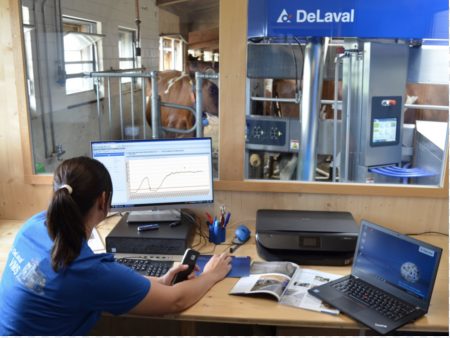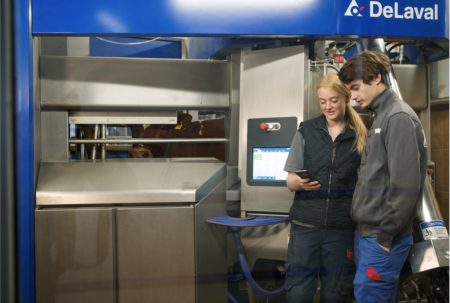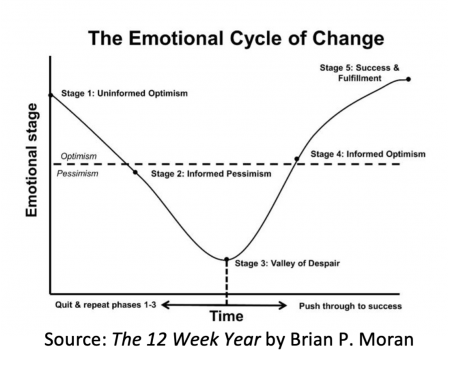You can’t talk about the future of dairy dairy farming without including the word technology in the conversation. With labour increasingly hard to find, many farms are looking to add state-of-the-art solutions as a next step.
Work smarter
The goal of technology on the farm is to make daily tasks simpler, and if an increase in production is not possible, the focus should shift to an increase in production per labour unit. Dairy farms can be difficult to calculate production per labour unit when it is an owner operator farm as many employees participate in farming tasks from field work to livestock management. As the farms grow in size to owner-managed and owner-governed, employees take on more specialized roles and the tasks and the productivity per employee is more clearly defined.
Examples of simplifying tasks on a dairy farm through the use of technology range from something as simple as an automated feed pusher to a much larger capital investment like a robotic milking machine. These examples both remove tasks from the daily workload and can work throughout the day when it is most difficult to find the time, particularly for owner-operated farms. The feed pusher ensures feed is always available and a milking robot allows her to milk on her schedule. But, a key component of the feed pusher is the feed itself. Is the farmer making sure that there is feed available to push? Something as simple as shifting from feeding to an empty bunk to feeding with increased refusals at the bunk was new to the robotic world, and it influences visits to the robot. Producers must be open to why the availability of feed is key when purchasing a feed pusher for a robotic barn. Conventional farms are able to feed in a different way by increasing or decreasing their refusals, depending on how they measure productivity. Feed availability does not influence the number of milkings in the parlor each day in a conventional barn.
Set expectations
Technology aiming to replace labour provides results with varying success. When the expierience of implementing new technology rises above the expectation, everyone benefits. The results matching up with expectations usually occurs when everyone does their homework. It is each person’s responsibility to do a proper investigation of what the product can do for their farm. Social media, the internet, open houses, farm tours and networking within the dairy community are important for gathering ideas.
For those that are first into a technology, these people have the most difficult job. Investigating a product that is new to your area brings with it many surprises, and this is typical for all parties invovled. The first users must have the right mindset to deal with the unexpected findings, and both the farm and the dealer need the right attitude and resources to buffer the surprises. The technology supplier also needs to ensure they will provide the resources necessary to work through unexpected findings. As products get a foothold in your area, it is easier to find farms to visit and a dealership wth experience.
Work with an experienced partner
The key is working with a dealership that has the reputation of listening to your ideas and guiding you with options that match up with your expectations. An experienced dealer can offer valuable advice and can help farmers stay grounded in their expectations of a new product’s potential performance. If what you want to achieve with what you are wanting to buy does not historically match with the dealer’s experience, try understanding why. There is a difference between pushing the limits and driving production or efficiencies and expecting to accomplish the impossible.
Shift your behaviour
Technology that requires people to change the way they work and use data in new ways is at a higher risk of disappointing some because buying technology, buying change is easy. The difficult part is transitioning and working in new ways with new processes that deliver the results you want. James Clear, author of Atomoic Habits, offers this advice, “Be humble about what you know, be confident about what you can learn.”
When people are open to what those with experience with the technology advise, they adjust their ways of working and the results should shift from what you were getting to what you want. An example of this is working on a dairy farm with a schedule that suits a conventional parlour farm. When beginning with robotics, the value of the robotic system, beyond ceasing the attachment of cups with manual labour, is to allow cows to milk more often. The challenge is that on paper there are 24 hours in the day, and we can calculate how many milkings are possible and therefore how many cows can milk based on the farm’s goals for individual cow production. What we sometimes do not account for is the behaviour of the people and the cows. A system needs to be developed on the farm to allow cows to be trained and an environment that rewards cows for milking 24 hours of the day, minus the wash times. If the conventional schedule remains in the behaviour of the people in the barn, then the conventional behaviour of the cows is at a high risk of remaining.
A clear example is a farm with 50 cows per robot not achieving the number of milkings that they expected, which leads to lower total milk production per robot than what was expected. While there is ample time on the robot to achieve the milkings calculated on paper, did the behaviour in the barn change to have those milkings in the afternoons and more importantly between 11 p.m. and 5 a.m.? Farmers who do not accept, learn and develop the processes required to achieve their goals using the new technology may be left disappointed.
Set yourself up for success
In looking at the many different farms visited, there are happy owners of technology at all different levels of production and output. When I see people who are happy, I see people that are appreciative of the support that they get and they are realistic about what the technology can and should do. When interacting with unhappy people, I often see a lack of ownership for what is realistic and what is not. To be fair, anyone unhappy due to a faulty product or issues with installation, they have a right to be. During the homework phase, the quality of the product and project quality should be assessed and finding businesses that represent the quality of work that you need and are willing to pay for is critical. Short cuts are part of human nature. Be prepared if a short cut leads to dissatisfaction in results. What can be done at that time? Should the results be accepted, or is it possible to work on a plan to fix it?
As the world conitnues to innovate, the solutions of the future will continue to amaze us. Simplicity is key to the success of tomorrow’s new technology with user-friendly interfaces and intuitive operation. If a product does not meet your criteria for performance and support, have an open conversation with the manufacturer’s representation. Understand who will support you, and how that support will work. In the first year of using new technology, is their support included in a program? Will you have to pay for it beyond that?
Buying new technology can work, and usually it isn’t the technology itself that is so important, it is the network of people supporting its successful operation. Listening to those with experience, developing relationships with trusted partners and learning to work in new ways, is the key to ultimate success.
Get original “Bullvine” content sent straight to your email inbox for free.
[related-posts-thumbnails]










 Focus on the change: what is needed to implement it, including support to help you change your thinking? This whole process is called the Emotional Cycle of Change and as you become aware of it, you will see many people follow a pattern as seen in this graph.
Focus on the change: what is needed to implement it, including support to help you change your thinking? This whole process is called the Emotional Cycle of Change and as you become aware of it, you will see many people follow a pattern as seen in this graph.



